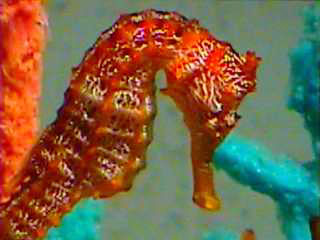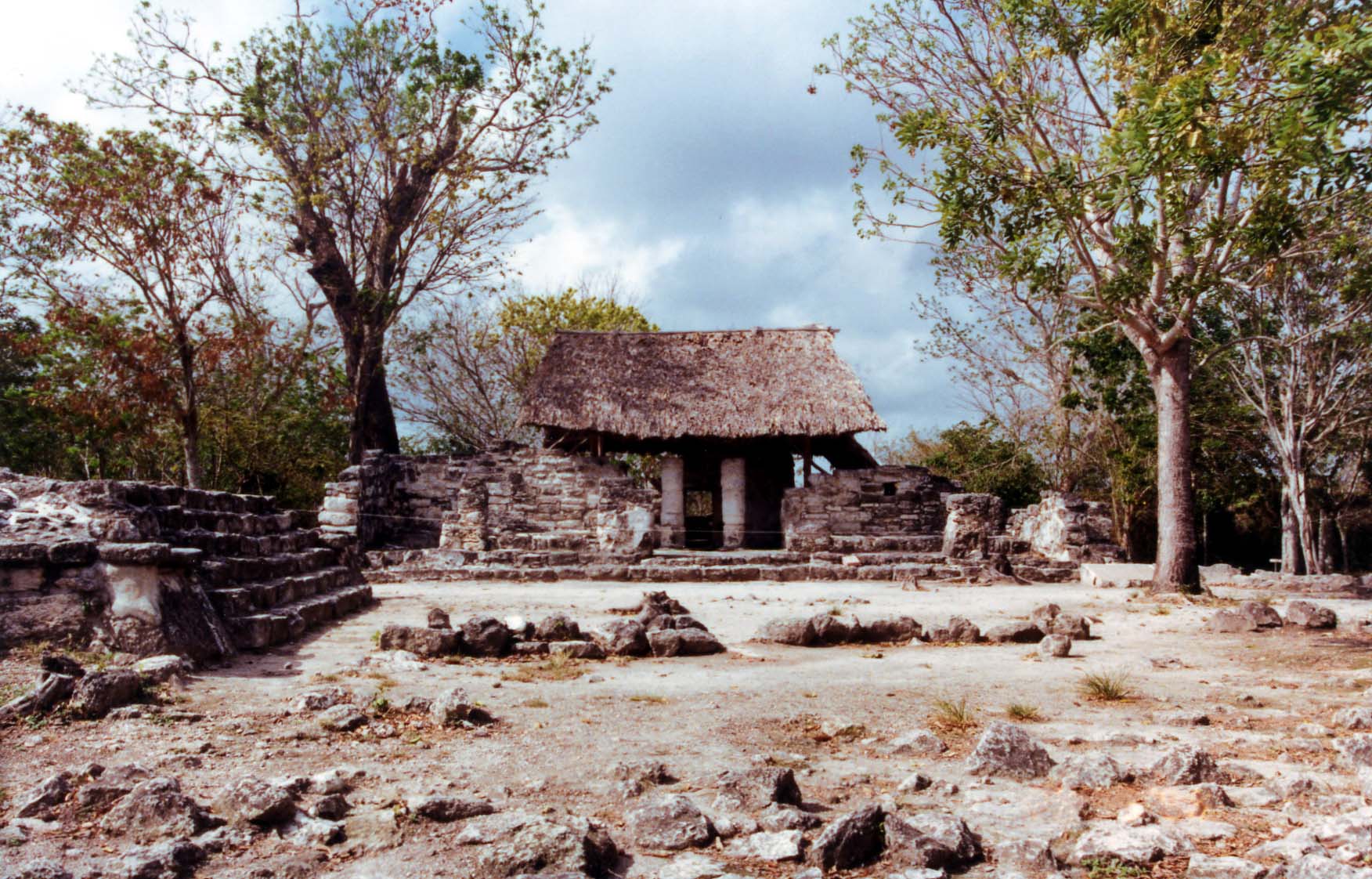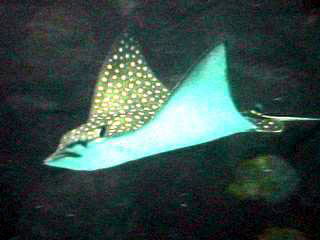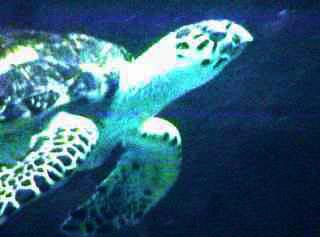

COZUMEL, MEXICO
The Ancient Maya worshipped a pantheon of gods but there was only one goddess, Ixchel, goddess of the moon, the sea and fertility and mother of the gods. It was here, on the island of Cozumel, the easternmost outpost of the Maya world, that her sanctuary was established around 800 AD. Eighteenth century Mayan scribes, in the Book of Chilam Balam of Chumayel, describe Cozumel as the center from which the Earth children multiplied 'like bees from a hive of honey.' Women crossed the 12 mile, 3000 ft. deep channel from the Yucatan to pay homage to Ixchel for whom at least thirty shrines were built. In 1511, when eighteen shipwrecked survivors drifted in a small boat to the eastern shore of Cozumel, islanders gave thanks for their bounty and Captain Valdivia and seven other Spaniards were promptly sacrificed at her altar and eaten.
 |
Seahorse Photo by Pico Castello |
Six years later, a Cuban fleet on a slave-hunting trip was swept by a hurricane to Cape Catoche at the tip of the Yucatan peninsula. After being lured ashore and attacked, the crew took refuge in a prayer house where they found baked clay idols and gold offerings. The small quantity of gold was enough to whet the appetite of Cuban governor, Diego Velazquez and the very next year, in 1518, he sent his nephew, Juan de Grijalva to the Yucatan to find the source of the gold and to claim the land for the Spanish Crown. Grijalva's ships were driven south by the currents to Cozumel but contrary to Valdivia's experience, the local people deserted their coastal villages to hide in the inland forests. Grijalva never found the source of gold and after skirmishes with fierce mainland tribes, he returned to Cuba without establishing the settlement that Velazquez needed to stake his claim. Consequently, Hernan Cortes was entrusted the following year with the same mission.
When Cortes arrived in Cozumel, timid villagers once again abandoned their homes and stone structures that contained tapestries, cotton hamacas and books made of fig bark. Two old men and an old woman were found hiding nearby in the bushes and with the help of Melchior, a mainland Mayan slave taken by the slave-hunters in 1517, they were assured that the Spaniards meant no harm. Enticed by gifts of green glass beads, the population returned to their villages and provided Cortes with supplies of fruit, fresh fish and honey. They also told Cortes of white men who lived on the mainland referring to the two remaining survivors from Valdivia's ship. The cacique suggested that Cortes send envoys with gifts to request their freedom. Gonzalo Guerrero had become a warrior and was married to a noble woman in Tulum. His body was tattooed and he wore rings in his ears, a gold bar in his nose and a large piece of jade in his lip. He chose to remain with his family and fought against the Spaniards in subsequent encounters. The other, Geronimo de Aguilar, a priest, survived as a slave. He joined Cortes and his command of the Maya language was instrumental in the eventual conquest of New Spain.
 |
San Gervasio |
During their month long stay on Cozumel, Cortes and his men destroyed many of the shrines to Ixchel. They hoisted a cross on the altar at San Gervasio and attempted to convert a bewildered populace. Even more devastating than the economic ruination caused by the loss of their shrines was the Spanish-borne smallpox epidemic that swept the island. Only fifty years later, the population of about 40,000 had been reduced to less than 300 people. Scattered ruins remain, the best preserved being those at San Gervasio, the largest site and once the administrative seat of Cozumel. Although not as dramatic as other Maya sites, there are several structures including a small pyramid and an interesting example of a stepped arch.
Cozumel became a favorite haunt of pirates but the population did not approach its pre-Columbian numbers until the arrival of 20th century pilgrims. Thousands bearing bread crumb offerings have come to pay homage at her underwater coral shrines. The island is a part of the world's second largest reef system, the Great Maya Barrier Reef that stretches from the Northern Yucatan to Honduras. It lies within an area known as the Yucatan Platform on top of an extinct volcano that was submerged millions of years ago. Alternating Ice Ages caused the sea level to rise and fall and the island was created by the gradual trapping of sand and mud behind an ancient reef system that had formed on top of the submerged volcano. The weathering of the exposed reef resulted in a coral island with a sharp, pitted 'ironshore' coastline that is surrounded by fringing reefs offshore.
 |
Spotted Eagle Ray Photo by Pico Castello |
Cozumel, Mexico's largest island, is 29 miles long and 12 miles wide. It is located in the Caribbean on the eastern side of the Yucatan Peninsula that is swept by a swift, north flowing branch of the Gulf Stream known as the Yucatan Current. On reaching southern Cozumel, the bifurcated current produces secondary currents of varying strengths. Consequently, drift diving, which dominates in Cozumel's waters, can be dangerous to the inexperienced wherever the full brunt of these currents are felt: namely, the choppy, exposed eastern shore, the southern reefs (Maracaibo and Chun Cha Cab) where unpredictable, reversing currents are common and the northwestern reefs (Barracuda and San Juan) that are washed by swift currents flowing into open waters.
Most diving is undertaken in the calmer waters of the southwest, leeward coast where a series of inner and outer reefs parallel the coastline and diffuse the 3 knot current that passes through the trench between Cozumel and the mainland. The constant flushing of these waters makes for excellent visibility (100 to 200 ft.) and the optimal growth of corals and sponges. Cozumel's walls and reefs are known as a spur and groove reef system. They have been sculpted over thousands of years and are characterized by a complex network of caves, holes and canyons or sand chutes that run perpendicular to the coast. 'Spurs' represent areas of coral growth while 'grooves' are sandy channels (sand chutes) formed by erosion resulting from surge currents that constantly replenish and drain the waters behind the reef. These sand chutes lead to wide sandy areas where patch reefs or bommies shelter vast numbers of Cozumel's marine life. The 1980 ban on fishing in these waters has gone a long way to protect reef fishes: southern stingray, spotted eagle ray, spotted moray, green moray, squirrelfish, bar jack, yellowtail snapper, porkfish, French grunt, Bermuda chub, butterflyfish, angelfish, creole wrasse and stoplight parrotfish are among the most plentiful. However, the ban does not extend to the heavily fished channel or the east coast which results in fewer deepwater species to be seen such as gray tipped sharks, barracudas and schools of horse-eye jack.
 |
Green Turtle Photo by Pico Castello |
Experienced divers will find the outer reefs' drop offs to be the most rewarding deep dive locations. They remain relatively pristine due to the requisite Intermediate to Advanced skills that substantially reduce the number of divers to these areas. The more southerly reefs (Columbia, Punta Sur) are especially impressive with massive coral pinnacles that rise over 90 ft. Drifting by these structures induces the sensation of flying, a magical experience that is enhanced in the early morning by shafts of sunlight that penetrate at an angle to create a surrealistic underwater panorama. The deep walls are a collage of brilliant colors and endless textures. Delicate, green clusters of hanging vine algae (Halimeda goreaui) grow amid patches of yellow encrusting sponges, blood-red rope sponges entwine the dainty, brown deepwater lace coral, tiny blue sea squirts colonize giant orange elephant ear sponges, wrinkly, blue iridescent tube sponges shimmer in the filtered, underwater light, while pale, purple sea fans and feathery sea plumes dance to the incessant rhythm of the reef. Caribbean waters possess the greatest variety of sponges in the world and Cozumel's reefs are prolific. At some places on the outer walls, sponges display weird, contorted shapes attesting to the presence of strong currents.
Deep dives for less experienced divers usually occur on the sheltered side of the outer reefs. Some locations such as the Big Horseshoe on Palancar have been badly damaged but most sites still provide the winning combination of warm, clear water, interesting reef architecture, sponge and coral gardens and a colorful assortment of marine life.
The shallower inner reefs are popular for second dives and novice dives while closer in, patch reefs or bommies are favored for night dives, shore dives and snorkeling. The majority of Cozumel's visitors make their way to these waters resulting in substantial coral degradation at Chankanaab, Corona and Yucab reefs while Paraiso was practically destroyed by the construction of the new cruise ship terminal. Although the inner reefs lack the topographical drama and lushness of the outer reefs, they do attract large numbers and varieties of reef fish. Spotted moray, resting nurse shark, lobster and the endemic splendid toadfish (Sanopus splendidus) hide among the nooks and crannies while aggressive schools of bar jack, sergeant major, yellow tailed snapper, Bermuda chub and blue striped grunt prowl the waters around hotel docks and near Chankanaab National Park in search of indulgent tourists. They are obviously accustomed to being fed in spite of recommendations to the contrary.
In addition to the waters close to shore, there are two excellent snorkel sites at Columbia Shallow and Palancar Shallow. The Columbia Lagoon is a large mangrove area located at the southern end of the island. Nutrient rich material passes from the lagoon to the sea where it is transported by the current to feed the reef. Both the lagoon and the turtle grass meadow that extends from the mouth of the lagoon to the Columbia reef form an extensive nursery for juvenile fish. Consequently, every type of reef fish can usually be seen in Columbia Shallow on the sheltered side of the reef. Other sightings include the sea turtle (April to September), lobster, black tip shark (in winter when the water is cooler) and a variety of coral patches. Fortunately, the integrity of this site has been preserved due to its distance from popular dive sites and the reduced visibility of its food-laden waters. Although Palancar Shallow also has coral heads, sponges and reef fish, its main attraction to the snorkeler is the ability to follow the sand chute to the drop off at Palancar Caves. The drop off begins in about 20 feet of water and it is one of the safer places for snorkelers to glimpse some of the holes and convoluted tunnels of the outer reef.
Currently, the fate of Cozumel's reefs hangs in a balance as commercial interests vie with those of the reef. The long term effect of the new cruise ship terminal on nearby reefs has not yet been determined but there are already plans to build another pier at the north end of the island, adding another 100,000 visitors per year to Cozumel's water. Hopefully, moderation will prevail and Cozumelenos will choose to protect 'the goose that laid the golden egg.'
Best Times To Go:
Getting There:
Mainland ferries leave from Playa del Carmen hourly from 5:00 am to 9:00 pm. There are two types of service: the fast boat and the slow boat. The fast boat is more comfortable and costs about $15 one way, only a few dollars more than the slow boat. There are several options for getting to Playa del Carmen from Cancun. One way approximate costs are as follows: Taxi ($70 - $75), airport transfer van ($20), airport transfer express bus ($15), bus from the Cancun bus terminal ($10). Current prices and information are available at the transportation desk at the Cancun airport or at any hotel desk in the hotel zone.
Clothing/Gear:
General Information:
Accommodations to the north of San Miguel are mainly all inclusive hotels and private villas that are categorized as expensive. Some of the hotels offer 'dive packages' but these are subcontracted and involves being picked up and taken to a dive shop's pier since none of these hotels have their own docks. Transportation and the distance to the popular reefs are the primary considerations. One option to overcome some of the inconvenience is to rent a car which negates having to make advanced arrangements for early morning dives and also allows the diver flexibility in selecting his/her own dive shop.
Hotels within San Miguel are usually the most modestly priced on the island and are within walking distance of the town pier, the main pick up point for many dive shops. Those accompanied by non-divers may be attracted to the variety of restaurants and shops located in town.
The strip between San Miguel and the cruise ship terminal is heavily developed with 'dive hotels' that cater to divers and snorkelers. Most have on site dive shops but a few have an exclusive relationship with a specific dive shop. Some dive shops have developed a relationship with several hotels so it is possible to purchase a dive package from either the hotel or the dive shop. Hotels here vary from a basic room with A/C to varying levels of service and prices that range from moderate to expensive. South of the cruise ship terminal are a scattering of hotel resorts including the luxurious El Presidente. All of the hotels to the south of San Miguel offer opportunities for shore diving and snorkeling. They also have docks to facilitate pick ups by the dive boats. Of these hotels, only the Barracuda, Plaza las Glorias, Galapago Inn, Costa Club and perhaps Caribe Blu (formerly La Perla) are within comfortable walking distance to town.
There are three types of diving operations in Cozumel: hotel-based shops, independent shops and independent dive guides. Hotel-based and large independent shops service the bulk of the tourist trade and by necessity, must deal with people of differing skills. It is the frustration of mixed groups that has led to the success of small independent shops and the independent dive guides. However, some of the hotel-based and large shops counteract this by offering fast boats for smaller groups, EDPs (Experienced Diver Programs) and distinguish themselves in other ways. These shops also offer the full range of courses from introductory resort dives to advanced and specialty courses (underwater photography, Nitrox diving, Instructor Development, etc.). The dreaded 'cattle boats' are found among this group so if possible, choose the slightly more expensive fast boat.
The small independent shops and independent dive guides have two main attractions: price and flexibility. Although this group has some talented individuals, this should not be the choice for new divers. Experienced divers may try some of the small shops but should not commit to more than 2 dives until important factors such as safety measures can be appraised.
Dive Packages - All inclusive packages are bargains for those planning to take full advantage of three dives per day with no allowance for a day off or a day for sightseeing. For dive only packages, some shops offer multi-day packages where the price per dive decreases as the number of days increases. Be sure to check the refund policy before purchasing a dive package such as this. Others, like Dive Paradise, are more straightforward in their pricing where two dives cost $58 ($4 extra for a fast boat) and there are often specials for a third dive of the day resulting in a very reasonable per dive cost. This allows for unforeseen circumstances and avoids potential hassles with refunds for dives not taken.
Many dive boats will take on non-divers who want to snorkel. This is appropriate for advanced snorkelers but a snorkel boat is a better choice for the less experienced. Before purchasing a snorkel trip, inquire about the itinerary. If the word 'beach' is mentioned, it is probably a party boat with token snorkeling thrown in. A good snorkel trip will include at least 3 different reef locations for a half day's duration. The key to a pleasant, uncrowded experience is to schedule snorkel trips on those days when there are no cruise ships docked at the pier. Snorkel trips cost about $50 for half a day and $80 for a full day including soft drinks, lunch and the rental of mask, snorkel and fins.
Planning Tips:
1. Don't touch the coral or walk on the reef.
2. Don't use sun tan lotion as the chemicals are destructive to marine life.
3. Don't fish in protected waters. El Parque Marino Nacional Arrecifes de Cozumel encompasses the area from the town pier to the southern reefs.
4. Don't remove anything from the seabed or reefs.
5. Don't anchor on the reef or throw anything overboard.
1. You must make advanced arrangements for custom group trips, EDPs, specialized courses or requests for specific destinations.
2. Certified divers should consider a refresher course or the service of a private divemaster if you have no experience with drift diving.
3. Don't swim, dive or snorkel alone. This is tempting due to the ease with which these activities may be undertaken.
4. Always inform someone onshore of your dive or snorkel plans including your expected time of return.
5. Please heed your divemaster's judgment about Cozumel's currents which are subject to sudden changes in intensity and direction.
6. Check that your divemaster is currently certified by a recognized agency and that the dive boat carries oxygen on board.
7. Drink plenty of water to prevent dehydration.
1. Plan to visit the Museo de la Isla de Cozumel. It is located on the waterfront three blocks to the north of the downtown pier. There are some fine exhibits about Cozumel's natural history including its coral reefs. An open air restaurant on the second floor has a nice lunch menu and an excellent view of boats coming and going in the channel.
2. Take the time to explore the beautiful, windswept, eastern beaches that are wonderful for picnics, sunning and shell collecting. A strong undertow makes swimming dangerous except for a few sheltered areas.
Important Resources:
Individual situations vary so greatly that we make no specific recommendations for resort accommodations and/or dive shops. Cozumel's resources are already well represented on the Internet. Our suggestion is to identify the hotels and dive shops that meet your requirements and then use a search engine for more detailed information.
Related Books:

Adventures Great and Small © copyright 1996-2005